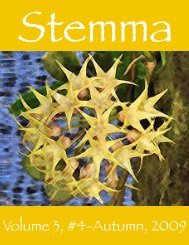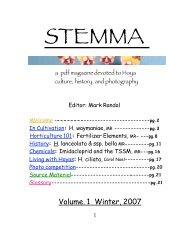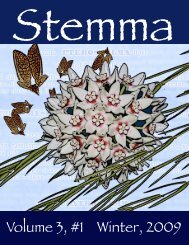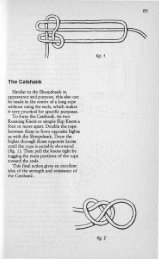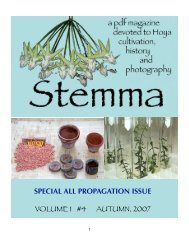Volume 3, Issue #2 - Cubits
Volume 3, Issue #2 - Cubits
Volume 3, Issue #2 - Cubits
You also want an ePaper? Increase the reach of your titles
YUMPU automatically turns print PDFs into web optimized ePapers that Google loves.
The pollinaria of Eriostemma species seem to have<br />
evolved a different mechanism for attaching themselves to<br />
the bodies of visiting pollinators. In Hoya species, the pollinaria<br />
are formed on the corona with their pollina held out<br />
straight, extending towards the center of the corona (figure<br />
4). When the pollinia are pulled from their positions over the<br />
stigma, the pollinia usually spring inwards, crossing each<br />
other and forming a clasp in which a portion of the pollinators<br />
body may be trapped (figures 5 & 6- the red dots indicate<br />
the likely place where a pollinators leg or proboscis<br />
would be trapped.)<br />
In Eriostemma species, the pollinarium hold their pollinia in<br />
a different position, the base of each held far out from the<br />
corpuscula, the pollinia apex angled inwards, almost touching<br />
(figure 1). When Eriostemma species pollinaria are removed<br />
from the stigma, the pollina tend to swing away from<br />
each other, rather than towards each other, as in Hoya, possibly<br />
due to the twisted nature of the translators/caudicles. In<br />
figure 2, the top pollinarium has both pollina sprung into<br />
their secondary position, the lower two have one each of<br />
their pollinia swung to their secondary position. No studies<br />
seem to have been done to determine the actual method of<br />
polliarium transfer for Eriostemma, but it seems logical that<br />
the likely place for attachment to a visiting pollinator for<br />
these species would be in the complexly twisted translators/<br />
caudicles themselves (figure 3, with two red dots highlighting<br />
the likely place of attachment). n<br />
28



